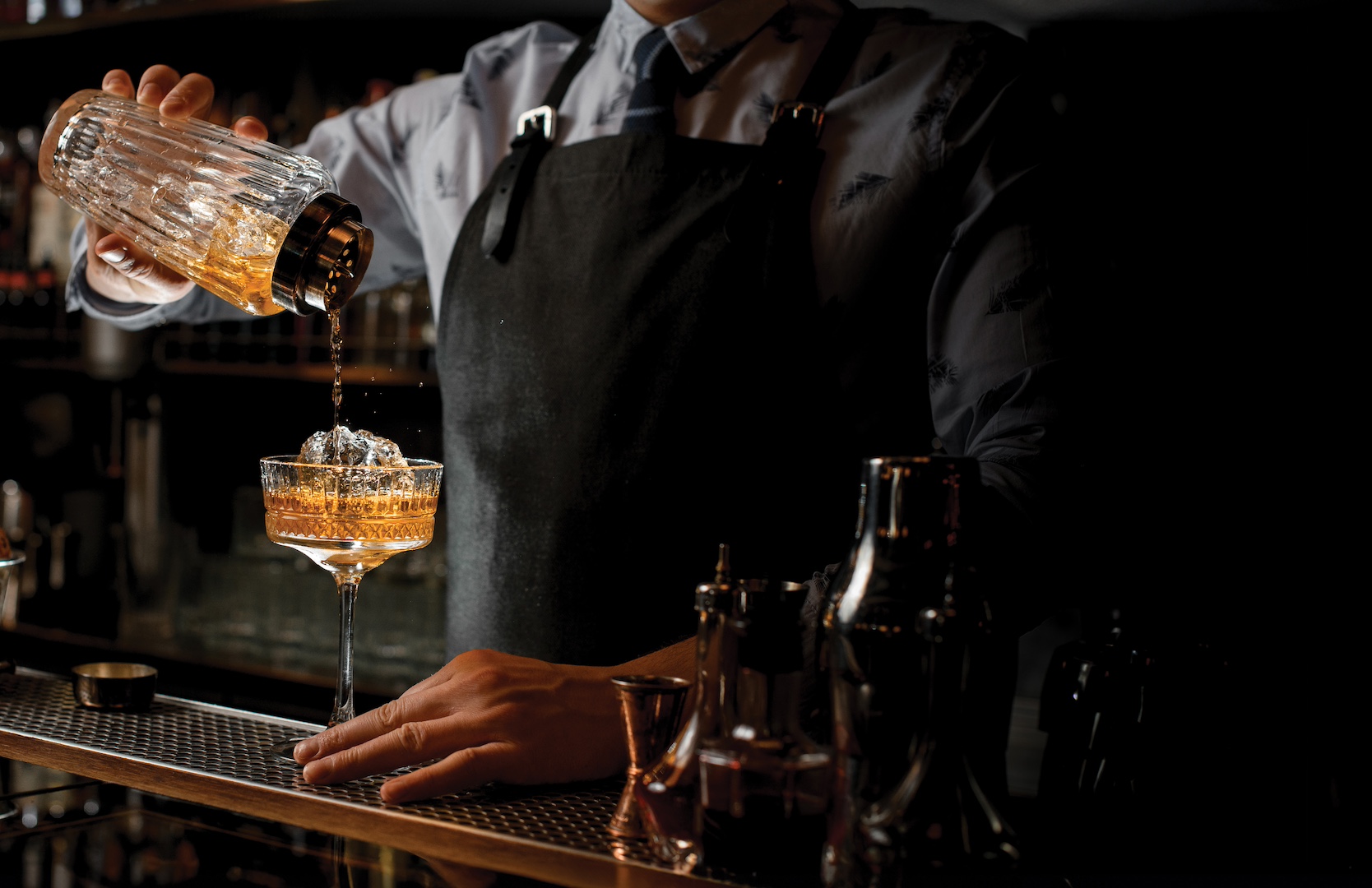Down The Hatch
Explore how apothecaries made way for contemporary cocktails and modern-day mixology.
Long before contemporary speakeasies and Jay Gatsby’s storied soirées, the humble cocktail was simply a salubrious sipper. The word “cocktail” first appears in a 1798 British newspaper, and historians believe its origins come from batch punches served in English punch houses in the 18th century. As the term made its way to America, it became defined as a beverage containing spirits, water, sugar, and bitters. That recipe remains the basis for bartenders today.
Liqueurs and spirits like Benedictine and absinthe are reappearing on cocktail menus. Whether in a Benedictine-laced Old Fashioned or an absinthe and champagne cocktail, these age-old ingredients are being used in contemporary ways. At the turn of the century, it was not uncommon for these spirits to be prescribed for curing common ailments.
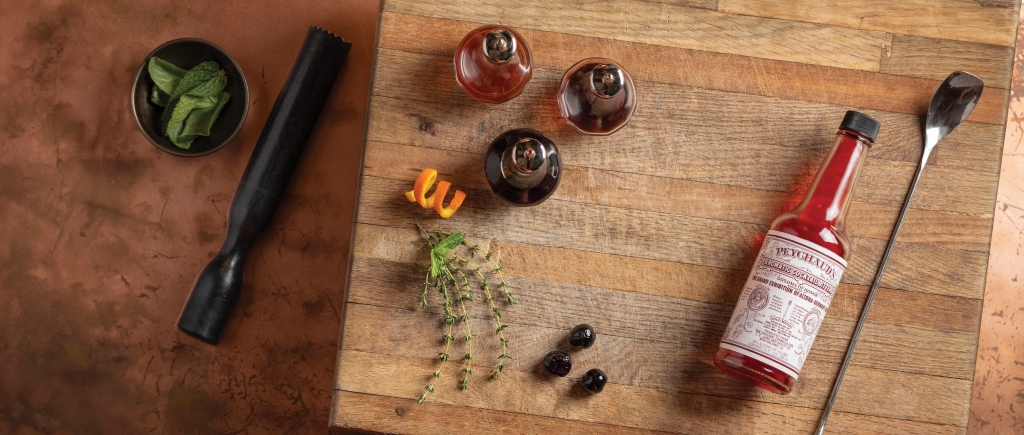
Early apothecaries incorporated medicinal flowers and herbs into drinks with distilled spirits to heal ailments.
According to historians, cocktail recipes and subsequent consumption peaked between the 1860s and Prohibition, earning this time period the moniker of “the Golden Age of Cocktails.” Using the standard method, innovative bartenders began concocting their own creations. Many of today’s go-to cocktails would be unrecognizable a century ago. Take the daiquiri for example. Beachcombers closely associate this rum-based drink with fruity flavors blended with ice until smooth. The original recipe, however—and the one so loved by Ernest Hemingway—called for only rum, sugar, and lemon. Similarly, the martini’s origin is a surprising separation from what we know as a martini today. One of the first recipes on record combines gin, vermouth, bitters, maraschino liqueur, and a slice of lemon. Later methods remove the sweet and sour ingredients leaving a 1:1 ratio of vermouth and gin behind.
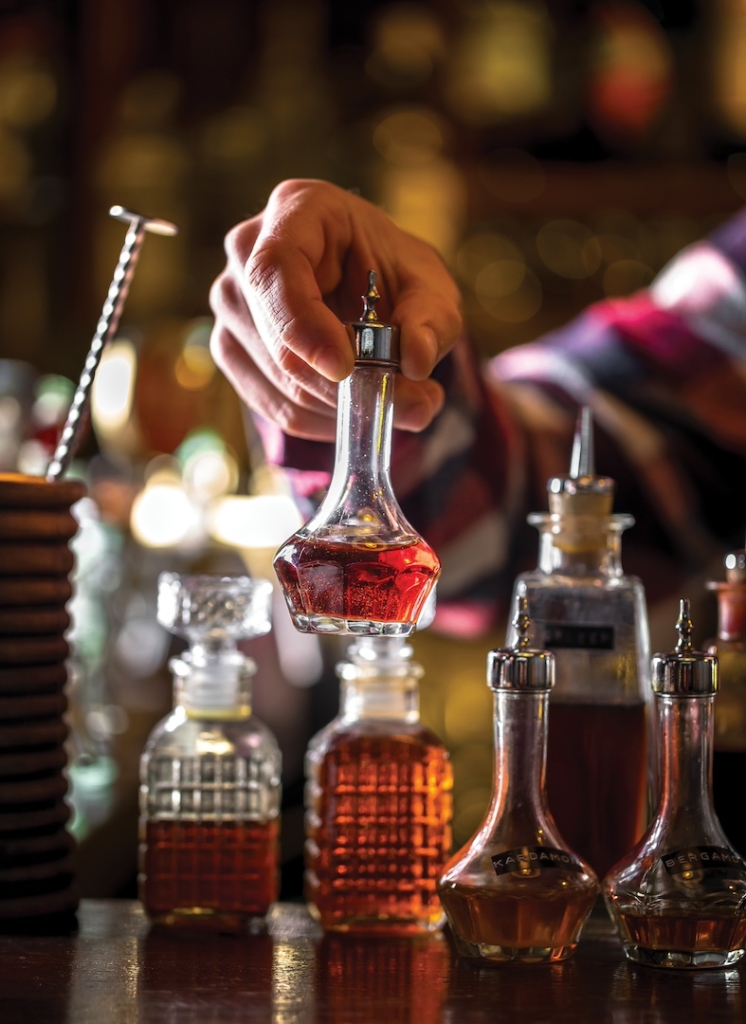
Bitters, such as Peychaud’s (above), started as therapeutic herb-based dashes and drops.
However, before these chilled concoctions became commonplace on restaurant menus, cocktails were the creations of pharmacists. Alcohol, thanks to its preservation qualities, was a common solution for ailments. Historically speaking, sanitary practices were lacking, and germs were rampant. Alcohol was used to prolong the life spans of natural elements such as medicinal flowers and herbs, and this stock was often found at the local apothecary. Here, a pharmacist could prescribe simple liquid solutions to heal ailments by mixing various substances. A Sazerac, for example, was specifically created to aid in gut health, curing common stomach pains caused by spoiled food and water.
The Sazerac has roots in New Orleans. Antoine Peychaud, a Creole apothecary from present-day Haiti, is credited with inventing the drink in his apothecary at 437 Royal Street. Peychaud was especially drawn to cognac, particularly the brand of the liqueur from the French-owned brand, Sazerac de Forge et Fils. The recipe called for an absinthe rinse, two ounces of cognac, a sugar cube, and a few dashes of Peychaud’s eponymous bitters. Once absinthe was banned in the U.S. and cognac could no longer be imported, the drink shifted to include Herbsaint and rye whiskey, respectively. Peychaud’s recipe remains in circulation at bars to this day and has even been dubbed the official drink of New Orleans.
In fact, at their inception, cocktails were meant to be strictly medicinal. Those sweet, fruity notes that we are accustomed to today were frowned upon. The reason? The herbaceous properties from bitters would hinder overconsumption. At their core, cocktails were meant to help people, often being named after the ailment striking the consumer.
“Back in the day, apothecaries were one of the highest regarded people in the town they worked in,” says Megan Corrigan, lead bartender at River Bar. “It’s important for all our bartenders to understand what came before us, why we use the ingredients that we do, and how we use them.” At Sea Island, knowing the original cocktail recipe—spirit, sugar, bitters, and water—is the key to being able to create new cocktails. “You have to know all those components before breaking it down to build a drink.” Whether mixing an Old Fashioned or a Negroni, the foundation is the same.
Bitters are the salt and pepper of the cocktail world, and they are defined as roots, herbs, spices, and other aromatic ingredients that have been macerated in a high-proof spirit for an extended amount of time. Blended with other ingredients, they’re used to offset the sharper components and textures of cocktails.
PEELING BACK THE POWER OF CITRUS 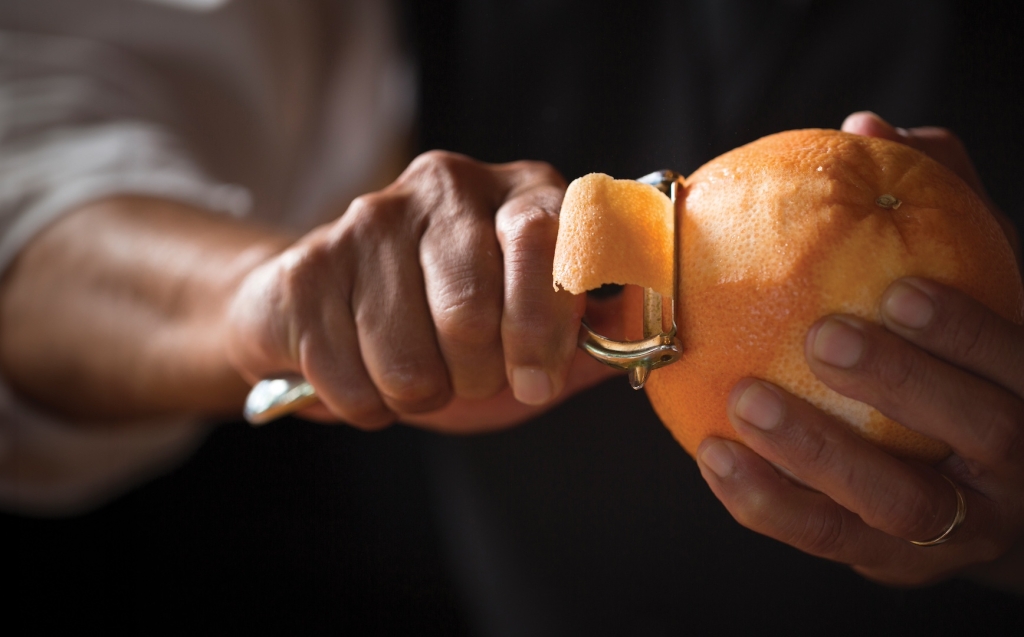
Orange peels have a deep history in the spirits world. Throughout the 19th century, citrus was frequently added to sugar-forward drinks, often rum or gin, to help treat maladies related to Vitamin C deficiencies. It was discovered that the more sour citruses, like lemons and limes, actually tasted better when bitters were added to the mix. Today, citrus offers balance and brightness to many beloved cocktails. It has the power to transform beverages —either enhancing flavors or taming them, depending on the other spirits or bitters that are in play.
The two oldest bitter companies in the world are Peychaud’s and Angostura, each one having profound impacts on the bitters industry and becoming a staple ingredient for hobby and professional mixologists. Andrew Buchwald, lead bartender at Roshambo in Atlanta, says today’s imbibers are even more in tune with bitters than they once were. “One of my regulars recently ordered a club soda with bitters to help soothe his stomach,” he says.
Savory, herbaceous-style cocktails have risen in popularity over the past few years. Besides a push from consumers for fresh, unprocessed ingredients, there’s a desire for the simplicities of the past. Buchwald explains, “Cocktails are thought-provoking and balanced. We’re not making sugary concoctions anymore. Instead, people want to taste those interesting layers and see how a drink pairs with their food.” Drinks prepared with spices and herbs fuse bites with sips, each taste illuminating the previous one.
Much like beautiful plates of food, people drink with their eyes first, too. Buchwald, who spent over a decade in the apparel industry in visual merchandising, says that a cocktail with unique coloring or in a specialty glass is going to spark curiosity and conversation. “People will almost always ask about a specific drink I am making; those moments are part of why this job is rewarding.”
Buchwald precisely measures the ingredients for a Last Word, a gin-based Prohibition Era cocktail made with equal parts gin, green Chartreuse, maraschino liqueur, and lime juice. He vigorously shakes the blend for at least thirty seconds before pouring it into a dainty coupe glass. A Luxardo cherry sinks to the bottom, and he passes the beverage to the patron who gives him a nod of approval. The shared cocktail experience connects the modern world to a past one. “Cheers,” they both say in unison.
HOUSE REMEDIES
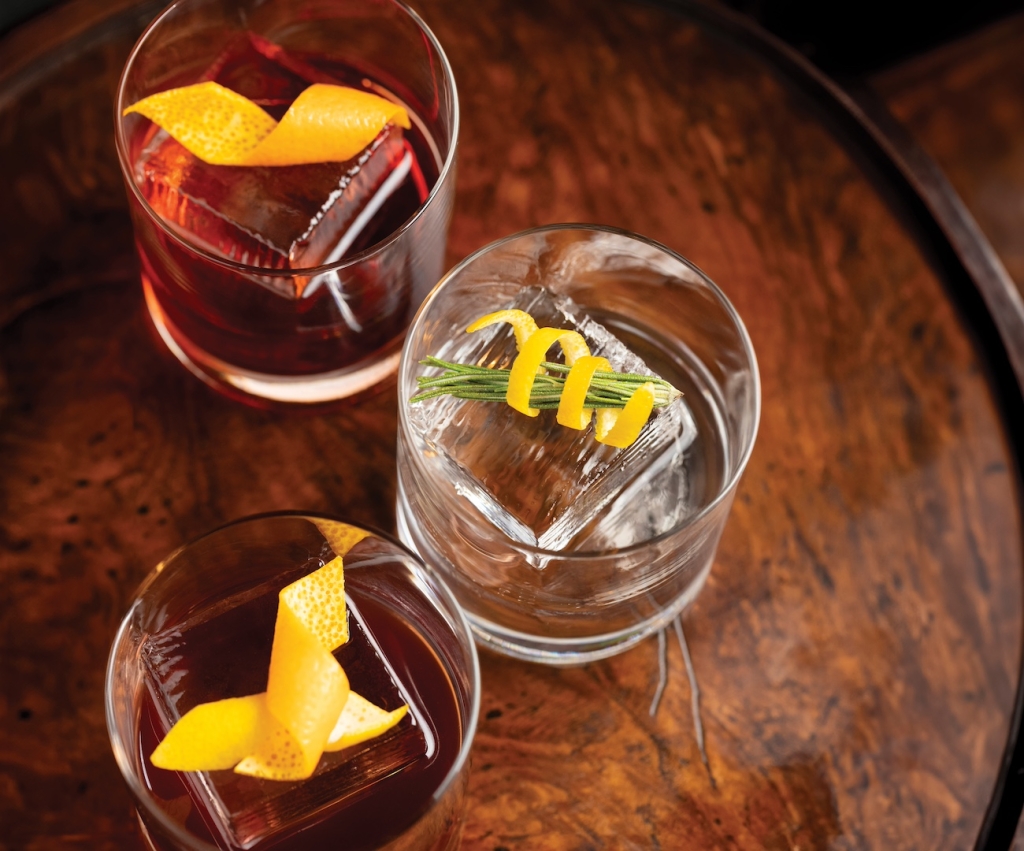
Inspired by libations of old, Sea Island opens their vault with three signature recipes that offer more than just a nod to the past. Designed to evoke the feeling of a 19th-century apothecary, these recipes may be just what the doctor has ordered to get creative juices, and cocktails, flowing at home.
Colt’s Remedy
- 1 ounce, Michter’s US1 Small Batch Bourbon
- 3/4 ounce, Dolin Rouge Vermouth
- 1 ounce, Campari
- 1/4 ounce, St. Elizabeth’s Allspice Dram
Glass | Rocks ICE | 2” Cube Garnish | Orange Peel
Combine all ingredients in a mixing glass with ice. Stir for 5 to 6 seconds. Strain over fresh ice then garnish and serve.
Vanilla – Seasonal “Single Ingredient” Menu Challenge, 2023
- 1 ounce, Vanilla Bean infused Dickel White Corn Whiskey
- 1 ounce, Dolin Blanc
- 1 ounce, Ahus Akvavit
- 3 dashes, Barrel Aged Vanilla Bitters
Glass | Double Rocks ICE | 2” Cube Garnish | Rosemary Sprig + Lemon Curl
Combine all ingredients in a mixing glass with ice. Stir for 5 to 6 seconds. Strain over fresh ice then garnish and serve.
Bulleitproof Priest
- 1 ounce, Bulleit Bourbon
- 1 ounce, Cocchi Americano Rosa
- 1 ounce, Lustau PX Sherry
- 1/4 ounce, Angostura Bitters
Glass | Rocks ICE | 2” Cube Garnish | Orange & Lemon Peel
Combine all ingredients in a mixing glass with ice. Stir for 5 to 6 seconds. Strain over fresh ice then garnish and serve.
